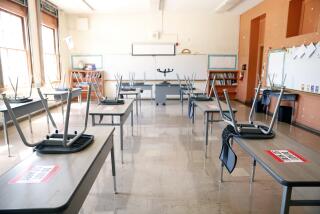An Equation Is a Girl’s Best Friend
- Share via
The squeaky sound of platform sandals and sneakers reverberated across Cal State Fullerton’s McCarthy Hall on Thursday morning as 23 high school girls frantically raced up and down stairs and escalators in search of math scavenger-hunt clues.
With pad, pencil and calculator in hand, 15-year-old Priya Gandhi bolted across a hallway in search of the room that would contain the coveted envelope with the next math problem.
“There it is,” Gandhi screamed as she grabbed the white envelope from a door and plopped on the floor to work with teammates Rosa Rivas, Janeth Zepeda and Tracy Valdez.
Games such as the scavenger hunt, Linear Jeopardy and Algebra-nopoly are some of the ways the university’s Math Intensive Summer Session (MISS) made algebra fun and hands-on for the 49 girls in this year’s four-week program.
MISS was launched more than a decade ago to reverse the steep drop in math performance in girls between elementary and high school.
Rita Colwell, the first female director of the National Science Foundation, described a “valley of death” in education, in which female students in grades 4 through 8 lose interest in math and science because of peer pressure and lowered expectations of teachers, counselors and family members.
In a supportive girls-only environment, MISS prepares Orange County high school girls from disadvantaged backgrounds who want to pursue higher education.
This year’s MISS program consisted of two classes to prepare girls for Algebra I and II--regarded as “gatekeeper” courses that can become stumbling blocks for some students hoping to apply to competitive four-year post-secondary schools.
The brainchild of Cal State Fullerton math professor David Pagni and campus tutoring center director Ina Katz, MISS began in 1990 with 32 girls. This year, more than 80 applicants submitted transcripts, teacher recommendations and an essay.
The MISS program comes at a time of slow growth rates for women in science and math fields. Although the number of women in sociological and biological sciences has increased, less than 10% of the nation’s engineers are women, said Ruta Sevo, director of the National Science Foundation’s program for gender equity in science, mathematics, engineering and technology.
Sevo said less than 30% of computer science professionals and 23% of physical scientists are women.
Over the next decade, Sevo said, another 2.2 million workers will be needed in the sciences and in engineering, fields that will require people with strong math backgrounds.
“Our nation’s growth is limited if we don’t produce more people with science and technology skills,” Sevo said. “If we bring more women and more minorities into the workplace, it will give us a competitive advantage and show leadership internationally.”
Educators and scientists say programs such as MISS help students feel at home with math and science.
“Some of our traditional approaches to education in science and math have made it seem hard ... or have made it seem ‘not for me’ to most students,” Sevo said. “We’re trying to reverse that image because most children are naturally very excited about science ... and we are trying to sustain that interest. These programs are helping us change education to become more inclusive.”
Although research suggests that teaching a mixed pool of students is an asset for classes, educators also believe that single-gender courses such as the MISS program help boost students’ self-confidence and provide a nonthreatening environment.
The National Science Foundation’s Colwell remembers her encounter with stereotypes when her high school chemistry teacher refused to write a recommendation letter for her to study chemistry in college.
“He said girls couldn’t do chemistry really well,” Colwell said in a telephone interview. “There is a tendency in schools to make preordained assumptions that girls don’t like math and can’t do science, ... which is really unfortunate and not well-founded. You then get your expectations fulfilled and that’s not good for the country.”
For incoming Newport Harbor High School junior Mariela Manriquez, being part of the MISS program will help her prepare for an Algebra II honors class this fall and for college admissions. She hopes to go into a field involving mathematics after college.
“I feel that girls have to prove that we can do it,” Mariela said as she sat doing homework in her family’s living room in Costa Mesa. “The program helps us feel more confident in ourselves and to be confident in achieving anything.”
As her mother, Ninfa, and 1-year-old cousin, Araceli, watched her do homework, Mariela explained that her mother and father, originally from Mexico, had to leave school in the elementary grades to help support their families. She plans to be the first in her family to go to college.
“It’s a big responsibility,” she said. “All their hopes are on me.”
Pagni said that more than 90% of MISS graduates have gone on to college or university.
MISS alumna Natalie Solon, 28, remembers her experiences in the first and second summers of the Cal State Fullerton program.
“They made it so fun that you didn’t get scared if you didn’t do the problems correctly.”
Solon earned a master’s degree in business administration, but has returned to the Fullerton campus to get credentials to teach high school math.
MISS, she said, gave her an educational foundation as well as something even more valuable. “I learned that I can do anything I set my mind to do.”
More to Read
Sign up for Essential California
The most important California stories and recommendations in your inbox every morning.
You may occasionally receive promotional content from the Los Angeles Times.













